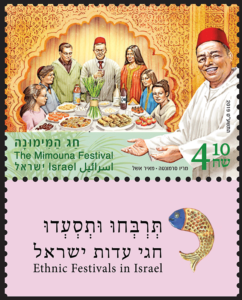 Date of Issue: 01 May 2019
Date of Issue: 01 May 2019
Denomination: NIS 4.10
Size of Stamp: W: 40 mm H: 30
Plate no.: 1120
Designers: Mario Sermonte, Meir Eshel
Printers: Cartor Security Printing, France
Printing method: Offset
Sheet type: Mini Special Sheet (Teth Besh Sheet)
No. of stamps in sheet: 8 (8 tabs)
Place of cancellation: Jerusalem
No. of FDCs: 1
Price of FDCs: NIS 5.30
From Israel Post:
When the State of Israel was founded and its gates were opened to Jews from around the world, the wave of Olim (new immigrants) which had been rising since the end of the 19th century became a virtual flood. Entire communities from around the globe gathered their belongings and made their way to the Land of their ancestors. Each community brought its customary garb, special language, traditions and all of the other cultural components it had developed over centuries in the Diaspora.
In the early years of the State, Israel’s leaders had to cope with the huge challenge of formulating a new society, one that would incorporate people from Jewish communities around the globe. As part of the “melting pot” concept the new immigrants were expected to abandon the traditions they brought from their native lands and embrace the image and traditions of the new Israeli. This attitude changed over the years and was replaced by one that honored and cherished the immense cultural wealth brought by the Olim. Israeli cuisine adopted diverse flavors and foods originating around the world, Israeli music enriched its work with a broad range of tones and the Israeli calendar integrated holidays and festivals celebrated by the different ethnic groups. Some of these festivals have spread beyond their original ethnicity and are celebrated by Israeli society as a whole.
The Mimouna Festival
 The Mimouna festival stems from the Jewish community in Morocco and is celebrated in the evening of the last day of Passover. The Mimouna is meant to unify the Jewish community and its essence is the opening of homes and hearts to all who wish to join in the celebration. It is customary to open one’s door as a sign that all are welcome – family, neighbors, acquaintances and strangers alike.
The Mimouna festival stems from the Jewish community in Morocco and is celebrated in the evening of the last day of Passover. The Mimouna is meant to unify the Jewish community and its essence is the opening of homes and hearts to all who wish to join in the celebration. It is customary to open one’s door as a sign that all are welcome – family, neighbors, acquaintances and strangers alike.
The hosts make every effort to provide their guests with an enjoyable experience. They are received with a traditional greeting: Tirbachu Utis’adu which wishes them success and good fortune. Participants wear splendid traditional garb, including golden robes and colorful head- coverings. The gathering is accompanied by music, singing and dancing.
The hosts traditionally serve a lavish and diverse array of delicacies and sweets, most of which are prepared during the days of Passover. These dishes are made with ingredients that are strictly kosher for Passover. Also served is the traditional Mufleta, which is made of dough and prepared at the end of the holiday, just before being served to the guests.
The festive atmosphere continues the next morning, and it is customary to spend the day outside with family and friends.
After coming to Israel, the Moroccan community continued to celebrate the festival within itself and in 1965 the tradition was established in the format of mass celebrations for the general public. The Mimouna festival has acquired a place of honor among Israelis and is celebrated each year by most people.
Description of the Stamp
Photos of the gate, the doors and the plant – Shutterstock.
Photo of the fish – Pnina Barkay.
Photos of the host’s clothing and hat and the photo that inspired the family – courtesy of the World Federation of Moroccan Jewry.
With thanks to the World Federation of Moroccan Jewry.
This is the first in a series of three stamps. Two additional stamps featuring the Sehrane and Sigd festivals will be issued later this year.



